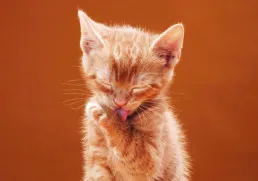Cats are masters of self-maintenance, spending up to half their day on grooming activities. If you’ve ever watched your feline friend meticulously licking their fur, you might wonder about the Cat Grooming Behavior behind it. This natural habit isn’t just about cleanliness—it’s a vital part of their health, social life, and well-being. Understanding why cats groom themselves can help pet owners spot potential issues early and provide better care.
For more insights into feline quirks, check out cat mannerisms explained.
 A cat grooming itself with its tongue, showing the flexible body and barbed tongue in action
A cat grooming itself with its tongue, showing the flexible body and barbed tongue in action
How Cats Are Built for Grooming
Cats are incredibly flexible, allowing them to reach nearly every part of their body for grooming. Their tongues are equipped with tiny, backward-facing barbs called papillae, made of keratin—the same material in human hair and nails. These barbs act like a natural brush, effectively removing loose fur, dirt, and parasites. Cats often swallow the ingested hair, which usually passes through their system harmlessly in healthy, short-haired breeds. They also use their paws cleverly: licking them wet and rubbing over the face like a washcloth.
Kittens learn this cat grooming behavior from their mothers early on. By two weeks old, they start grooming independently, perfecting the skill by weaning age. This instinctive routine keeps their coat shiny and skin healthy.
The Health Benefits of Grooming
Grooming plays a key role in maintaining healthy skin and fur. The licking action stimulates sebaceous glands at the base of each hair follicle, producing sebum—an oily substance that lubricates and waterproofs the coat for a glossy shine. It also prevents mats, sheds loose hair, and dislodges dirt or fleas, reducing parasite risks.
On hot days, grooming serves as a cooling mechanism. Cats sweat only through their paw pads, so saliva evaporation from licking helps regulate body temperature. Well-groomed fur fluffs up, promoting air circulation against the skin for better thermoregulation.
Explore related feline habits in cat actions.
Social and Emotional Roles in Grooming
Beyond physical care, cat grooming behavior fosters social bonds. Mother cats groom kittens to clean them and strengthen family ties—a behavior mirrored in wild felines like lions through allogrooming. This social grooming spreads a shared group scent, essential for pack recognition and unity in the wild. Domestic cats often groom their owners for the same reasons, showing affection and inclusion in their “pride.”
Grooming also calms cats during stress. Facing an aggressive animal or recovering from a mishap, they may groom excessively as displacement behavior. The rhythmic licking provides neurologic comfort, similar to how humans bite nails for tension relief.
Long-haired breeds like Persians benefit from owner-assisted brushing to prevent mats and hairballs, turning grooming into quality bonding time. Even short-haired cats enjoy it, viewing the brush as a social tool.
Grooming as a Health Indicator
Changes in cat grooming behavior signal potential health issues. Normal cats dedicate 30-50% of their day to grooming; a sudden decrease might indicate illness, leading to greasy fur, mats, or odors. Over-grooming can stem from parasites, allergies, arthritis, or pain—cats may lick sore joints excessively or neglect hard-to-reach areas due to mobility limits.
For instance, arthritis hinders flexibility, causing patchy grooming, while allergies prompt itchy over-licking. Behavioral stress or hidden pain can alter patterns too. If you notice shifts, schedule a vet visit promptly—early detection via grooming observation can prevent serious problems.
Learn about dominant traits in alpha female cat behavior.
Many owners see cats as “self-cleaning,” but all felines need occasional help, especially longhairs prone to mats. Regular brushing not only aids coat health but also lets you monitor for lumps, fleas, or skin issues.
When and How to Assist with Grooming
While cats excel at self-grooming, certain situations call for human intervention. Breeds like Bengals surprisingly enjoy baths, and long-haired cats require weekly brushing to avoid hairballs—ingested fur can form dangerous blockages. Use a soft brush to mimic their tongue, starting slowly to build trust.
Bathing is rare but necessary for severe dirt, fleas, or medical reasons. Use cat-specific shampoo, support their body fully, and dry thoroughly to prevent chills. Always consult a vet for persistent issues like excessive shedding or bald spots.
Conclusion: Monitor Grooming for a Happy Cat
Cat grooming behavior is multifaceted—essential for hygiene, cooling, bonding, stress relief, and health signaling. By observing it closely, you ensure your pet thrives. Changes warrant professional attention; pair home grooming with vet check-ups for optimal care.
Ready to enhance your cat’s routine? Share your experiences in the comments or explore more pet care tips on our site.
References
- Texas Veterinary Medical Foundation (TVMF): Original insights from Dr. Elizabeth Fowler, DVM.
- American Veterinary Medical Association (AVMA): Guidelines on feline dermatology and behavior.
- Merck Veterinary Manual: Parasites, allergies, and arthritis in cats.
